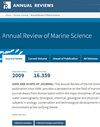切萨皮克湾水的清晰度:挑战和成功。
IF 18.9
1区 地球科学
Q1 GEOCHEMISTRY & GEOPHYSICS
引用次数: 0
摘要
切萨皮克湾是一个跨越多个司法管辖区的大型河口系统,是全球河口健康的典范。从历史上看,营养物负荷降低了水质,促使需要进行监管。水的清晰度是水质的一个组成部分,对底栖生物群落至关重要,是整个生态系统健康的关键指标。在这里,物理再悬浮和盐度梯度、养分和沉积物输入、浮游植物产生的有机碎屑以及底栖生物群落都相互作用,驱动着具有高空间变异性的清晰度模式。过去50年的趋势显示出改善,尽管由于沉积物输入减少和藻类因光照限制而释放,有机碎屑暂时增加。养分和沉积物投入的持续减少提高了所有指标的清晰度,并使水下水生植被重新扩大。未来的管理应继续减少营养物和沉积物的投入,同时解决与气候有关的河口动态变化。本文章由计算机程序翻译,如有差异,请以英文原文为准。
Chesapeake Bay Water Clarity: Challenges and Successes.
The Chesapeake Bay is a large estuarine system spanning multiple jurisdictions and serves as a model for estuarine health worldwide. Historically, nutrient loading degraded water quality, prompting the need for regulation. Water clarity, one component of water quality, is vital for benthic communities and serves as a key indicator of overall ecosystem health. Here, physical resuspension and salinity gradients, nutrient and sediment inputs, production of organic detritus by phytoplankton, and benthic communities all interact to drive clarity patterns, with high spatial variability. Trends over the last 50 years show improvement, though with a temporary increase in organic detritus in response to reduced sediment inputs and algal release from light limitation. Continued reductions in nutrient and sediment inputs have led to improved clarity across all metrics and a re-expansion of submerged aquatic vegetation. Future management should continue reductions in nutrient and sediment inputs while addressing climate-related shifts in estuarine dynamics.
求助全文
通过发布文献求助,成功后即可免费获取论文全文。
去求助
来源期刊

Annual Review of Marine Science
地学-地球化学与地球物理
CiteScore
33.60
自引率
0.60%
发文量
40
期刊介绍:
The Annual Review of Marine Science, published since 2009, offers a comprehensive overview of the field. It covers various disciplines, including coastal and blue water oceanography (biological, chemical, geological, and physical), ecology, conservation, and technological advancements related to the marine environment. The journal's transition from gated to open access through Annual Reviews' Subscribe to Open program ensures that all articles are available under a CC BY license, promoting wider accessibility and dissemination of knowledge.
 求助内容:
求助内容: 应助结果提醒方式:
应助结果提醒方式:


